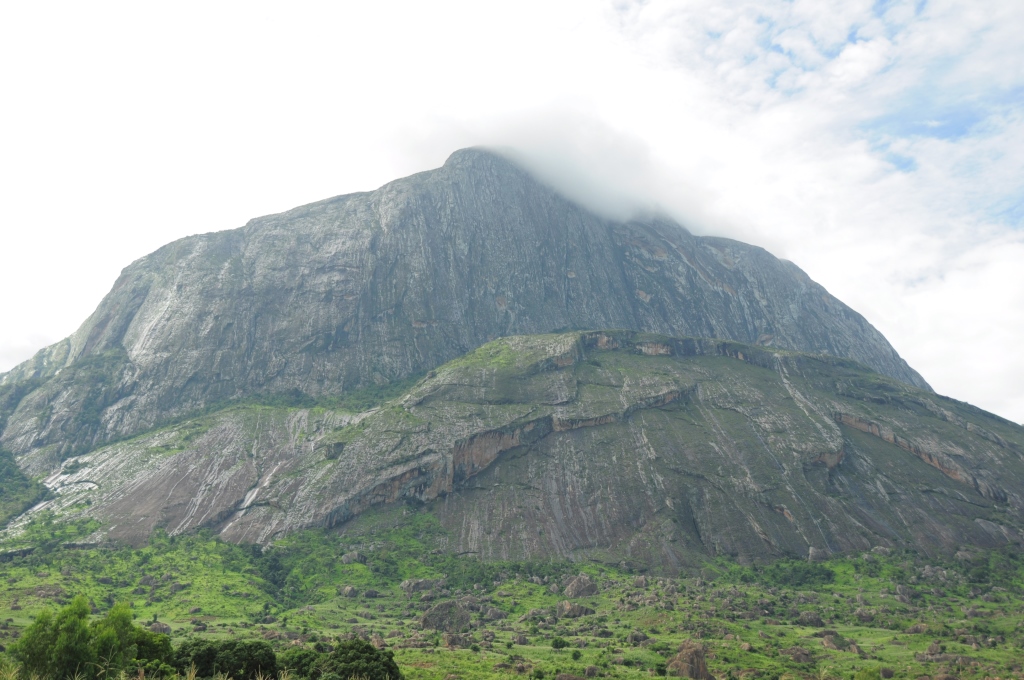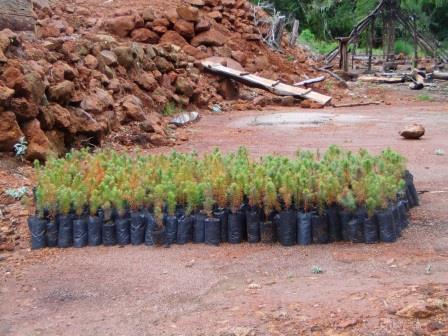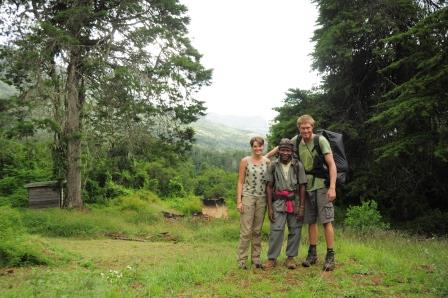Mount Mulanje is Malawi’s highest mountain, with its highest peak, Sapitwa (meaning: don’t go there) reaching 3001 metres.  We’d always said that we would climb this mountain, as it is very beautiful and remote – perfect for us!
We’d always said that we would climb this mountain, as it is very beautiful and remote – perfect for us!
Having reached the Likhabula Forestry Office we soon met our guide Ramson and sorted out the route that we would be taking: First night at Chambe hut; ascend Sapitwa Peak the following morning; Thuchila hut on the second night; descend to Likhabula on the third day. 
At 05:30 the next morning we got up, made sure that we were packed and ready to go and met up with Ramson. The three of us headed up the very steep mountainside, enjoying the spectacular views, lush rainforest and beauty around us. Along the way Ramson told us all about the various fauna and flora surrounding us, giving us insight into both the local community, as well as the mountain itself.
The path was very slippery and following the trail required a lot of concentration. Unfortunately, Astrid’s foot started hurting and to top it all, it started raining as well.  Taking a breather at the halfway mark, Ramson decided to help Astrid by taking her pack. Even though this helped, it did not improve the pain in her foot, making us aware of an apparent chronic injury. Great!
Taking a breather at the halfway mark, Ramson decided to help Astrid by taking her pack. Even though this helped, it did not improve the pain in her foot, making us aware of an apparent chronic injury. Great!
Despite that, we made it to Chambe hut and were greatly impressed by what seemed to us an alpine chalet, which could have been taken from anywhere in the Alps. The caretaker had stoked a roaring fire in the cabin, allowing us to dry all our wet gear, play Bao with Ramson and generaly rest and recuperate in the warm and dry.  By late afternoon the rain had stopped, leaving behind mist covered views of Chambe Peak in front of us. What a wonderful setting!
By late afternoon the rain had stopped, leaving behind mist covered views of Chambe Peak in front of us. What a wonderful setting!
That afternoon we decided to change our plans and bypass summiting Sapitwa the next day. There was just too much cloud cover, the paths were too wet and slippery and the last stretch to the summit is an unsecured scramble over large boulders, not really worth it in the terrible weather we’d been having. So the decision was made to take an alternate route to the other side of Mulanje, namely to Lichenya hut.
Feeling much better in the morning, Astrid decided  to carry her pack again and we set off meandering across an amazing plateau. It was a strange setting to be in, with mountain peaks hidden in the mist, meadows covered in wild flowers, dense rain forests and fields of proteas scattered between it. It felt very mystical with the fog banks rolling over and obscuring everything, only allowing occasional glimpses of blue sky and sun. Definitely very dramatic!
to carry her pack again and we set off meandering across an amazing plateau. It was a strange setting to be in, with mountain peaks hidden in the mist, meadows covered in wild flowers, dense rain forests and fields of proteas scattered between it. It felt very mystical with the fog banks rolling over and obscuring everything, only allowing occasional glimpses of blue sky and sun. Definitely very dramatic!  Lichenya hut is situated in the middle of a pi
Lichenya hut is situated in the middle of a pi ne forest covered in Old Man’s Beard. Once again we were welcomed by a warm fire and had the lovely log cabin all to ourselves. We watched the rain and the Blue monkeys go by, thinking what a wonderful place we were in and how much we would enjoy coming back here with family and friends. We would sit around the fire at night, grilling marshmallows and chatting. Maybe some day we’ll have company and do just that. 🙂
ne forest covered in Old Man’s Beard. Once again we were welcomed by a warm fire and had the lovely log cabin all to ourselves. We watched the rain and the Blue monkeys go by, thinking what a wonderful place we were in and how much we would enjoy coming back here with family and friends. We would sit around the fire at night, grilling marshmallows and chatting. Maybe some day we’ll have company and do just that. 🙂
The following morning Astrid’s feet were still hurting, but we had no choice but to start down the mountain to Likhabula. The descent offered great views over the areas below Mulanje, allowing you to appreciate both the height and the steepness of the descent. In some places you really do not want to take a wrong step – if you do, you’ll have a long drop and a sudden stop at the end. 
By the time that we reached the car we were very relieved. Astrid could finally get off her feet, we could remain dry and we no longer had to pay attention to each step you took, in case you slip and fall. Over all we had an amazing time hiking on Mount Mulanje. We had been warned before coming that the conditions would not be ideal, but to us the rain and fog only enhanced the beauty and the mystique of the mountain. For everyone who enjoys hiking, Mount Mulanje is definitely a major highlight for anyone visiting Malawi.
During our time on the mountain we also came across Mulanje Cedar, which only grows on the mountain. It is highly prized for its rarity, as well as its value as a beautiful carving wood. Unfortunately, the Cedars are being illegally logged across the mountainside, but the authorities are introducing Cedar plantations to the lower slopes to prevent the poaching. All products of Mulanje Cedar from the Likhabula craft market are from the plantation and therefore legal. The crafters here are some of the best we have found so far, their work is very exact, creative and beautiful, so if you’re looking for a wonderfully carved Bao game, some jewellery or a perfectly fitted box, you can get it here at Malawian prices.
mountain we also came across Mulanje Cedar, which only grows on the mountain. It is highly prized for its rarity, as well as its value as a beautiful carving wood. Unfortunately, the Cedars are being illegally logged across the mountainside, but the authorities are introducing Cedar plantations to the lower slopes to prevent the poaching. All products of Mulanje Cedar from the Likhabula craft market are from the plantation and therefore legal. The crafters here are some of the best we have found so far, their work is very exact, creative and beautiful, so if you’re looking for a wonderfully carved Bao game, some jewellery or a perfectly fitted box, you can get it here at Malawian prices. 



